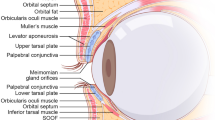Abstract
Background
The medial zygomaticotemporal vein (MZTV), clinically known as sentinel vein, has been observed in the vicinity of the temporal branch of the facial nerve during endoscopic procedures aiming to lift the upper face. The aim of the present study was to describe the topography of the MZTV with reference to the superficial landmarks for providing detailed anatomical information during injectable treatment procedures.
Methods
Eighteen hemifaces were harvested from nine embalmed Korean adult cadavers (5 males and 4 females, mean age 76 years). The piercing location, vascular diameter, drainage pattern of the MZTV, and its relationship with the orbicularis oculi muscle (OOc) were recorded photographically, and using diagrams and written notes.
Results
The piercing point of the MZTV was located 26.8 ± 5.9 mm from the lateral epicanthus, 18.8 ± 6.9 mm lateral to the plane (HP) through the tragus and the lateral epicanthus, and 19.0 ± 5.4 mm superior to the plane (VP) through the lateral epicanthus point and perpendicular to the HP. The diameter of the MZTV at the piercing point was 1.9 ± 0.8 mm. All of the MZTV ultimately connected with the middle temporal vein (MTV). In particular, the MZTV was connected the MTV by anastomosing with the periorbital vein. Anastomosis of the MZTV and a well-developed periorbital vein was found in 27.8 % of cases.
Conclusion
The physician must determine the location of the MZTV and should be able to accurately estimate its connection with significant veins at the temple to reduce the risk of severe complications during injectable treatments.





Similar content being viewed by others
References
Bozikov K, Shaw-Dunn J, Soutar DS, Arnez ZM (2008) Arterial anatomy of the lateral orbital and cheek region and arterial supply to the ‘peri-zygomatic perforator arteries’ flap. Surg Radiol Anat 30:17–22
Cvetko E (2003) A case of an unusual arrangement of numerous tributaries to the middle temporal vein and its fenestration. Surg Radiol Anat 35:355–357
De La Plaza R, Valiente E, Arroyo JM (1991) Supraperiosteal lifting of the upper two-thirds of the face. Br J Plast Surg 44:325–332
Engelman DE, Bloom B, Goldberg DJ (2005) Dermal fillers: complications and informed consent. J Cosmet Laser Ther 7:29–32
Feinendegen DL, Baumgartner RW, Schroth G, Mattle HP, Tschopp H (1998) Middle cerebral artery occlusion AND ocular fat embolism after autologous fat injection in the face. J Neurol 245:53–54
Fulton J, Caperton C, Weinkle S, Dewandre L (2012) Filler injections with the blunt-tip microcannula. J Drugs Dermatol 11:1098–1103
Gold M (2009) The science and art of hyaluronic acid dermal filler use in esthetic applications. J Cosmet Dermatol 8:301–307
Henry SL, Weinfeld AB, Sharma SK, George TM, Kelley PK (2012) The reliability and advantages of the sentinel vein as a microsurgical recipient vessel. J Reconstr Microsurg 28:301–304
Lee JG, Yang HM, Hu KS, Lee YI, Lee HJ, Choi YJ, Kim HJ (2014) Frontal branch of the superficial temporal artery: anatomical study and clinical implications regarding injectable treatments. Surg Radiol Anat. doi:10.1007/s00276-014-1306-6 [Epub ahead of print]
Lemperle G, Rullan PP, Gauthier-Hazan N (2006) Avoiding and treating dermal filler complications. Plast Reconstr Surg 118:92–107
Lopez R, Benouaich V, Chaput B, Dubois G, Jalbert F (2013) Description and variability of temporal venous vascularization: clinical relevance in temporoparietal free flap technique. Surg Radiol Anat 35:831–836
Murray CA, Zloty D, Warshawski L (2005) The evolution of soft tissue fillers in clinical practice. Dermatol Clin 23:343–363
Park TH, Seo SW, Kim JK, Chang CH (2011) Clinical experience with hyaluronic acid-filler complications. J Plast Reconstr Aesthetic Surg 64:892–896
Sabini P, Wayne I, Quatela VC (2003) Anatomical guides to precisely localize the frontal branch of the facial nerve. Arch Facial Plast Surg 5:150–152
Trinei FA, Januszkiewicz J, Nahai F (1998) The sentinel vein: an important reference point for surgery in the temporal region. Plast Reconstr Surg 101:27–32
Veyssiere A, Rod J, Leprovost N, Caillot A, Labbé D, Gerdom A, Lengelé B, Benateau H (2013) Split temporalis muscle flap anatomy, vascularization and clinical applications. Surg Radiol Anat 35:573–578
Yang HM, Won SY, Kim HJ, Hu KS (2013) Sihler staining study of anastomosis between the facial and trigeminal nerves in the ocular area and its clinical implications. Muscle Nerve 48:545–550
Conflict of interest
None of the authors have financial or private relationships with commercial, academic, or political organizations or people that could have improperly influenced this research. All authors were well-informed of the WMA Declaration of Helsinki-Ethical Principles for Medical Research Involving Human Subjects - and confirmed that the present study firmly fulfilled the declaration. All cadaveric objects in this study were legally donated to Yonsei Medical Center, Gachon University of Medicine and Science and Dankook University College of medicine.
Author information
Authors and Affiliations
Corresponding author
Additional information
H.-M. Yang and W.-S. Jung contributed equally to this work.
Rights and permissions
About this article
Cite this article
Yang, HM., Jung, W., Won, SY. et al. Anatomical study of medial zygomaticotemporal vein and its clinical implication regarding the injectable treatments. Surg Radiol Anat 37, 175–180 (2015). https://doi.org/10.1007/s00276-014-1337-z
Received:
Accepted:
Published:
Issue Date:
DOI: https://doi.org/10.1007/s00276-014-1337-z




